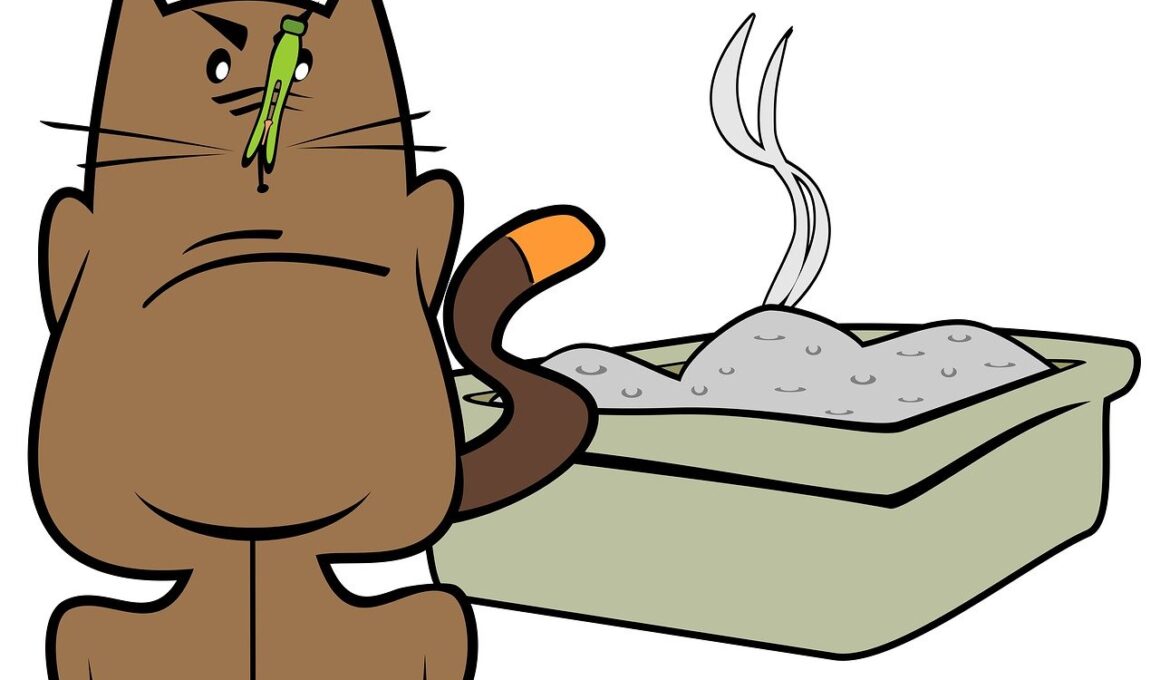Maintaining Hygiene in Portable Litter Boxes: Best Practices
Keeping your cat’s portable litter box clean is a crucial part of pet care. A clean environment not only promotes good health but also encourages your cat to use the box regularly. Cleaning should be a routine practice since cats are naturally clean animals. Here are some best practices to maintain hygiene effectively. First, scoop out clumps and waste daily. A dedicated scoop will make this easier while minimizing odors. Second, wash the litter box with warm, soapy water at least once a week. Use non-toxic cleansers to ensure your cat’s safety. Furthermore, consider replacing the litter entirely every few weeks, depending on usage. This will help prevent odors and bacteria buildup. Lastly, remember to clean the surrounding area to eliminate stray litter or potential messes. By following these simple steps, you create a more inviting space for your pet. A well-maintained litter box can make a substantial difference in your cat’s well-being. With adherence to these hygiene practices, you set up a foundation for happy living for both you and your furry friend.
Another integral aspect of maintaining hygiene in portable litter boxes revolves around litter choice. Various types of litter exist, each offering distinct benefits. Some common options include clumping litter, crystal litter, and biodegradable alternatives. Clumping litter forms solid waste pods, making removal straightforward. Crystal litter absorbs moisture and reduces odors effectively. On the other hand, biodegradable options are environmentally friendly, breaking down naturally over time. When selecting litter, consider your cat’s preferences as well. Cats often have a strong preference for texture, which can affect usage. Alongside choosing the right litter, monitor your cat’s reaction to it. If they avoid the box, consider trying a different type. A positive litter experience encourages consistent use, reducing messes and health concerns. Additionally, experiment with litter box location. Finding the perfect spot is key; it should be quiet, private, and easily accessible. Avoid areas with high traffic or noise, as these may deter your cat. Creating an environment where your cat feels safe to relieve itself is vital for maintaining hygiene successfully. Remember, a comfortable cat is more likely to maintain consistent litter box habits, leading to cleaner spaces.
Regular Maintenance of Portable Litter Boxes
Regular maintenance is essential for keeping your portable litter box in prime condition. Besides cleaning and habitual litter changes, there are crucial details that you should not overlook. For example, the type of portable litter box you select influences overall hygiene. Choose models that allow for easy access and cleaning. Boxes with lids or flaps can keep odors contained but should be checked often for buildup. Check litter depth regularly to ensure it remains sufficient for your cat’s needs. Insufficient depth may lead to escaping litter or poor elimination practices. Furthermore, avoid overcrowding the litter box; ideally, one box per cat plus an extra is recommended. This helps in preventing territorial disputes and keeping the areas cleaner. Utilize covers or shields designed to minimize litter tracking, further improving hygiene. Lastly, always remain diligent about monitoring your cat’s health. Any changes in their elimination habits may indicate a potential problem. By following strict maintenance and regular checks, you significantly reduce sanitation issues while enhancing your furry companion’s overall quality of life.
Proper disposal of used litter is another critical factor in maintaining effective hygiene in portable litter boxes. When it’s time to dispose of clumped litter, seal it in a plastic bag to minimize odor and mess. Avoid flushing the litter down the toilet, as this can cause plumbing issues and is not environmentally friendly. To make disposal easier, you might consider using a covered trash bin placed near the litter box. This helps contain any lingering smells and discourages messes. When replacing litter entirely, ensure you clean the box thoroughly beforehand. This step will eliminate lingering bacteria and odors, promoting a fresh start for your cat’s next usage. After cleaning, apply a light layer of baking soda, if desired, to absorb odors before adding new litter. This simple addition can enhance the usability of the litter box. In terms of frequency, always remember to assess based on your cat’s habits. Heavy usage may require more frequent cleanings and litter changes. Consistency in disposal practices also extends to keeping the trash bin empty and clean.
Understanding Your Cat’s Behavior
Understanding your cat’s behavior related to litter use is indispensable for effective hygiene management. Different cats exhibit varying preferences when it comes to litter and space. Pay close attention to your cat’s behavior, particularly any signs of reluctance to use the litter box. Such reluctance could indicate cleanliness preferences or issues with the litter itself. Sometimes, cats may prefer an uncovered box, desiring an open space for privacy and comfort. Conduct observational tests, trying different types of litter, box designs, or locations to find the ideal set-up. It’s essential to accommodate your cat’s needs for effective usage, avoiding issues like inappropriate elimination. Understanding stressors is also vital; a new household member, construction noises, or other factors can disrupt your cat’s regular habits. Create a calming space if you identify any stressors, ensuring your pet feels secure in their environment. Moreover, observing your cat’s behavior can highlight any health issues, potentially guiding you to veterinary advice. Being in tune with your pet’s wishes significantly contributes to hygiene and happiness in your shared living space.
Lastly, remember that a first-rate litter box hygiene regime involves not just cleaning but creating a positive experience for your pet. Start by selecting a portable litter box that fits seamlessly into your daily life and approach cleaning with a positive mindset. Use this routine as an opportunity to bond with your pet by talking calmly and assuring them during cleanup. If your cat is around while you tidy, it could build reassurance that their space is cared for. Each time you clean, check your cat’s overall health by observing for any changes in behavior or litter habits. Also, establish a consistent cleaning schedule that aligns with your daily routine to foster habits. Whether daily or weekly, having a routine makes it easier to maintain hygiene requirements steadily. Encouraging your cat’s positive behavior towards their litter box promotes good habits away from additional stress and mess. Ensure fresh litter and an inviting atmosphere are maintained, and your cat will remain happily engaged with their portable litter box. Following these practices will yield lasting benefits for both you and your furry friend.
In conclusion, maintaining hygiene in portable litter boxes demands a proactive approach. Established best practices, including daily scooping, thorough cleaning, intelligent litter choices, and observation of your cat’s behaviors, directly impact your cat’s willingness to use the box. Diligent care helps to ensure your cat’s health and comfort. By being attentive to changes in preferences and behaviors, you can adapt your routine accordingly. Additionally, consider the importance of a comfortable environment, offering your cat a stress-free space where they can feel secure. Remember, a clean litter box reflects not only your pet’s needs but your dedication as a pet owner, promoting harmony in your home. Regular cleaning and maintenance ensure that sanitation remains a top priority, allowing both pet and owner to thrive. Connecting cleaning routines to positive interactions enhances both your bond and your cat’s comfort. Ultimately, the success of maintaining a hygienic portable litter box lies in your dedication and consistency. Following these outlined strategies will undoubtedly contribute to a more hygienic living space for everyone. A happy, clean, and well-cared-for cat will reward you with companionship and affection, enhancing your home life significantly.
Helpful Tools for Easy Maintenance
Having the right tools for maintaining a portable litter box can greatly simplify the process. Consider acquiring a sturdy scoop, designed specifically for your litter type, to make daily cleaning efficient. Look for ergonomic designs that reduce hand strain during repetitive tasks. Additionally, invest in high-quality trash bags that seal tightly, which will help control odor during disposal. These are essential for quick clean-up. Another useful tool is a non-toxic cleaner that can be safely used to wash the box without risking your cat’s health. Include a spray bottle for easy application and rinsing. You may also consider a litter mat, which can keep excess litter from scattering outside the box, maintaining a cleaner surrounding area. An odor absorber or spray can also be effective in controlling unwanted smells. Lastly, a designated area rug beneath the litter box can enhance both safety and cleanliness. Keeping these tools handy will allow you to maintain the hygiene of your portable litter box with ease. Proper preparation leads to an efficient and streamlined cleaning process, making life better for both your cat and yourself.


